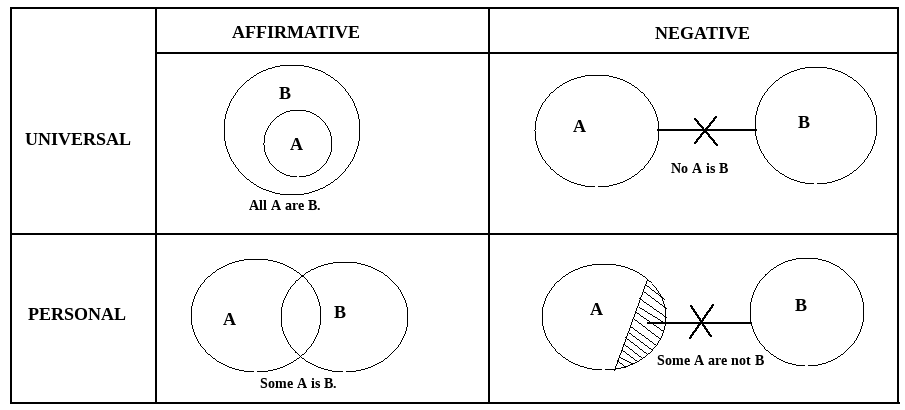Deductive Reasoning
Deductions (Syllogism) - Syllogism is the most logical chapter if we talk about logical reasoning. This chapter is also known as logical deduction & inductive reasoning. If we look closely, it's like a judicial judge who gives result or conclusion on the basis of proofs and evidence. The statements of the questions act like evidence, on the basis of this evidence you present conclusions. There are multiple approaches to solve the syllogisms questions but the Venn diagram is the most preferred method used to solve the questions of syllogism. Syllogism questions can be classified into three parts that are as follows -

Questions related to positive conclusions
Questions related to possibility conclusions
Questions related to negative conclusions
Let’s learn to draw a Venn diagram for the different statements of syllogism.

How to prepare syllogism?
Understand the statement and draw the minimum overlap venn diagram.
Check the positive conclusions directly.
Try to eliminate the negative conclusions.
In possibility conclusions, try to negate them and answer accordingly.
Practice as many questions as you can to be comfortable with every type.
Be comfortable with the trending phrases used to create confusion.
All questions of Deductions (Syllogisms, deductions)
Q 1.
Directions : Given two statements, verify the conclusions and mark the answer as given below.
Statements:
I. All hunters are punters II. Some punters are tigers
Conclusions:
I. Some hunters are tigers II Some punters are hunters
if only conclusion I follow.
If only conclusion II follows.
If either conclusion I or II follows.
If neither of the two conclusions follows.
If both conclusions follow
Q 2. Directions : Given two statements, verify the conclusions and mark the answer as given below.
Statements:
I. All boxes are pens II. All pens are dogs
Conclusions:
I. All boxes are dogs II. Some dogs are pens
if only conclusion I follow.
If only conclusion II follows.
If either conclusion I or II follows.
If neither of the two conclusions follows.
If both conclusions follow
Q 3. Directions : Given two statements, verify the conclusions and mark the answer as given below.
Statements:
I. Some boys are girls II. All girls are cute
Conclusions:
I. Some boys are cute II. All boys are cute
if only conclusion I follow.
If only conclusion II follows.
If either conclusion I or II follows.
If neither of the two conclusions follows.
If both conclusions follow
Q 4. Directions : Given two statements, verify the conclusions and mark the answer as given below.
Statements:
I. All books are pens II. All pens are pencils
Conclusions:
I. All books are pencils II. Some pens are pencils
if only conclusion I follow.
If only conclusion II follows.
If either conclusion I or II follows.
If neither of the two conclusions follows.
If both conclusions follow
Q 5. Directions : Given two statements, verify the conclusions and mark the answer as given below.
Statements:
I. Some singers are rockers II. All rockers are dancers
Conclusions:
I. Some rockers are dancers II. No singer are dancers
if only conclusion I follow.
If only conclusion II follows.
If either conclusion I or II follows.
If neither of the two conclusions follows.
If both conclusions follow
Q 6.
Directions : Given two statements, verify the conclusions and mark the answer as given below.
Statements:
I. No bars are coins II. All coins are books
Conclusions:
I. All coins are books II. Some books are not bars
if only conclusion I follow.
If only conclusion II follows.
If either conclusion I or II follows.
If neither of the two conclusions follows.
5)
If both conclusions follow
Q 7.
Directions : Given two statements, verify the conclusions and mark the answer as given below.
Statements:
I. Some copies are desks II. No desks are pen
Conclusions:
I. Some copies are pen II. Some copies are not pen
if only conclusion I follow.
If only conclusion II follows.
If either conclusion I or II follows.
If neither of the two conclusions follows.
If both conclusions follow
Q 8. Directions : Given two statements, verify the conclusions and mark the answer as given below.
Statements:
I. All boxes are pens II. No dogs are pens
Conclusions:
I. No boxes are dogs II. Some pen are boxes
if only conclusion I follow.
If only conclusion II follows.
If either conclusion I or II follows.
If neither of the two conclusions follows.
If both conclusions follow
Q 9. Directions : Given two statements, verify the conclusions and mark the answer as given below.
Statements:
I. Some cars are trucks II. Some trucks are buses
Conclusions:
I Some cars are trucks II. Some cars are not trucks
if only conclusion I follow.
If only conclusion II follows.
If either conclusion I or II follows.
If neither of the two conclusions follows.
5) If both conclusions follow
Q 10. Directions : Given two statements, verify the conclusions and mark the answer as given below.
Statements:
I. All locks are keys II. No key is a spoon
Conclusions:
I. No lock is spoon. II. No spoon is a lock
if only conclusion I follow.
If only conclusion II follows.
If either conclusion I or II follows.
If neither of the two conclusions follows.
If both conclusions follow
Q 11.
Directions : Given two statements, verify the conclusions and mark the answer as given below.
Statements:
I. All prisoners are men II. No men is educated
Conclusions:
I. All prisoners are uneducated II. Some men are prisoners
if only conclusion I follow.
If only conclusion II follows.
If either conclusion I or II follows.
If neither of the two conclusions follows.
If both conclusions follow
Q 12. Directions : Given two statements, verify the conclusions and mark the answer as given below.
Statements:
I. All flowers are candles II. All lanterns are candles
Conclusions:
I. Some flowers are lanterns II. Some lanterns are not flowers
repeat 11192
repeat 11192
repeat 11192
repeat 11192
repeat 11192
Q 13. Directions : Given two statements, verify the conclusions and mark the answer as given below.
Statements:
I. All flowers are candles II. All lanterns are candles
Conclusions:
I. Some flowers are lanterns II. Some lanterns are not flowers
if only conclusion I follow.
If only conclusion II follows.
If either conclusion I or II follows.
If neither of the two conclusions follows.
If both conclusions follow
Q 14. Directions : Given two statements, verify the conclusions and mark the answer as given below.
Statements:
I. All planets are moons II. All moons are stars
Conclusions:
I. All moons are planets II. All planets are stars
if only conclusion I follow.
If only conclusion II follows.
If either conclusion I or II follows.
If neither of the two conclusions follows.
If both conclusions follow
Q 15.
Directions : Given two statements, verify the conclusions and mark the answer as given below,
Statements:
I. All coins are crows II. Some crows are pens
Conclusions:
I. No pen is coin II. Some coins are pens
if only conclusion I follow.
If only conclusion II follows.
If either conclusion I or II follows.
If neither of the two conclusions follows.
If both conclusions follow.
Q 16. Directions : Given two statements, verify the conclusions and mark the answer as given below.
Statements:
I. All apples are oranges II. Some oranges are papayas
Conclusions:
I, Some apples are papayas II. Some papayas are apples
if only conclusion I follow.
If only conclusion II follows.
If either conclusion I or II follows.
If neither of the two conclusions follows.
If both conclusions follow
Q 17. Directions : Given two statements, verify the conclusions and mark the answer as given below.
Statements:
I. Some dogs are bulls II. No tigers are dogs
Conclusions:
I. No dogs are tiger II. Some bulls are tiger
if only conclusion I follow.
If only conclusion II follows.
If either conclusion I or II follows.
If neither of the two conclusions follows.
If both conclusions follow
Q 18. Directions : Given two statements, verify the conclusions and mark the answer as given below.
Statements:
I. Some bottles are pencils II. Some pencils are glasses
Conclusions:
I. No glass is bottle II. Some bottles are glasses
if only conclusion I follow.
If only conclusion II follows.
If either conclusion I or II follows.
If neither of the two conclusions follows.
If both conclusions follow
Q 19. Directions : Given two statements, verify the conclusions and mark the answer as given below.
Statements:
I. All fans are chairs II. No tables are fans
Conclusions:
I. No tables are chairs II. Some tables are chairs
if only conclusion I follow.
If only conclusion II follows.
If either conclusion I or II follows.
If neither of the two conclusions follows.
If both conclusions follow
Q 20. Directions : Given two statements, verify the conclusions and mark the answer as given below.
Statements:
I. All grasses are trees II. No tree is a shrub
Conclusions:
I. No grasses are shrubs II. Some shrubs are glasses
if only conclusion I follow.
If only conclusion II follows.
If either conclusion I or II follows.
If neither of the two conclusions follows.
If both conclusions follow
Q 21. Directions : Given two statements, verify the conclusions and mark the answer as given below.
Statements:
I. Some boys are thieves II. All thieves are dacoits
Conclusions:
I. Some boys are dacoits II. All dacoits are thieves
if only conclusion I follow.
If only conclusion II follows.
If either conclusion I or II follows.
If neither of the two conclusions follows.
If both conclusions follow
Q 22. Directions : Given two statements, verify the conclusions and mark the answer as given below.
Statements:
I. All women are mothers II. All mothers are sisters
Conclusions:
I. All womens are sisters II. Some women are not sisters
if only conclusion I follow.
If only conclusion II follows.
If either conclusion I or II follows.
If neither of the two conclusions follows.
If both conclusions follow
Q 23. Directions : Given two statements, verify the conclusions and mark the answer as given below.
Statements:
I. All plays are stories II. Some poems are plays
Conclusions:
I. Some poems are stories II. All stories are poems
if only conclusion I follow.
If only conclusion II follows.
If either conclusion I or II follows.
If neither of the two conclusions follows.
If both conclusions follow
Q 24.
Statements:
I. Some boxes are pens II. All dogs are pens
Conclusions:
I. Some boxes are pens II. Some pens are boxes
III. Some pens are dogs IV. All pens are dogs
1,2 & 3 follow
2,3 & 4 follows
None of These
1,2 & 4 follows
1,3 & 4 follows
Q 25. Statements:
I. All classes are books II. All pens are books
Conclusions:
I Some classes are pens II. Some pens are books
III. Some pens are classes IV. Some classes are books
None of These
Only 2 follow
1 & 2 follow
2 & 4 follow
Only 1 follow
Applications for Admissions are open.
Apply for Online M.Com from Manipal University
